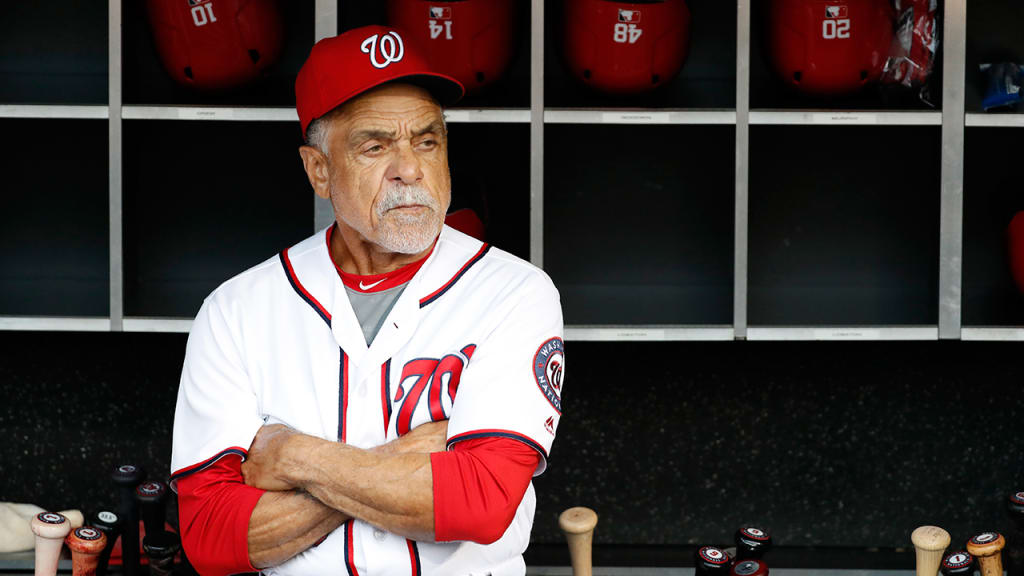Lopes shares insight on art of stealing bases

Nationals first-base coach Davey Lopes not only had instincts that allowed him to be one of the game's most successful basestealers as a player, he has also become one of the game's most respected teachers of the art of stealing bases.
A member of six postseason teams in his career, including the 1981 World Series champion Dodgers, Lopes was a four-time All-Star who finished in the top 10 in stolen bases 10 times, including leading the National League in 1975 and '76.
Lopes was successful on 557 of 671 regular-season stolen-base attempts, an 83-percent success rate that ranks fifth best since at least 1913. Tim Raines is the all-time leader at 84.7 percent. Lopes was also successful of 19 of 22 attempts in the postseason, succeeding on all 10 attempts in the 1981 playoffs.
Lopes talked about the art of stealing bases in this week's Q&A.
MLB.com: What was the motivation for you to become a basestealer?
Lopes: I came from an organization, the Dodgers, that loved to run. The main guy at that time was a Dodger, Maury Wills. I never did work with Maury, but through watching him, I think some of that had some kind of impact on how I developed as a basestealer. We had totally different philosophies, but the basics were there. The fact that the organization's geared to running, and they always had a couple of speed guys, that was such an important aspect of the game.
MLB.com: Was there a particular person who you learned from?
Lopes: Not to sound boastful, but you had to do a lot of things on your own back then. First of all, there weren't many guys that could teach me, because they didn't know anything about it. It was about trial and error. Some guys can do things with a bat, like a Tony Gwynn or a Rod Carew, all the great hitters. They had a special knack. They could see the ball and react. The ball would come to them. They could wait longer than most guys, still get the bat head out. I couldn't do that, as a hitter. I could do other things. I knew my niche was going to be speed, and that's what I had to utilize to get to the big leagues.
MLB.com: As an instructor, what is the most significant thing?
Lopes: You have to be fearless. I want you to be cocky, but humble. Good basestealers have an attitude. They like to run. You can actually control the game if you are good out there. The good basestealer intimidates. If the catcher threw me out, I would say, "What did I do wrong?" I would never wonder what he did right.
MLB.com: Rickey Henderson is a good example?
Lopes: He was the greatest in the history of the game. Everything was a plus-plus. There was nobody who put on a uniform that was a better leadoff hitter. When he got on base, the other team would do crazy things. Managers would call three or four pickoffs in a row. We have a kid now, if he continues to get on base, Trea Turner could be electrifying. Trey, Dee Gordon, Billy Hamilton -- I would like to put them in a track meet.
MLB.com: What about technique?
Lopes: I don't have set rules. A lot of kids do things differently than I used to, and it works. I have them get in a basic stance and see how they break off the bag. Then I watch him for a while. If he is successful, I don't care if it's unorthodox, I'm not going to mess with him. I do tell them their first movement is the direction they are heading. The first movement should be toward second base. Any other direction is wasted movement.
MLB.com: Haven't you said that a left-hander can be easier to exploit?
Lopes: Yes. You can see everything right in front of you. With a right-hander, his back is to you. You don't know for sure where the ball is. Is it in his hand or glove? You can't read the body as well.
MLB.com: What about the physical demands?
Lopes: I didn't get beat up. I only used one slide, feet first. Maury got beat up. He slid inside, outside, hook slide. Today, most guys do headfirst slides, but that's dangerous -- broken fingers -- and I don't think it is faster. What I did, I would come into the bag late. I'd have another running step at peak speed. The base stopped me. Headfirst, players have a longer slide and they slow down to go into the slide. The only way I would decelerate is when the bag stopped me.
MLB.com: Who were the toughest pitchers for you to steal against?
Lopes: Jimmy Kaat. He caught the ball, and he was ready to pitch. He didn't walk around the mound. He was literally going through a stretch position when the guy threw the ball back to him. He had to be ready, and he was so quick to the plate. That's the biggest weapon a pitcher can have, quickness. He has to give his catcher a chance to throw the runner out.
MLB.com: More often than not, it's the pitcher, not the catcher, you steal off?
Lopes: Usually. There are times catchers are going downhill or have some injuries. Time does that after you play enough. But the pitcher, if he doesn't get the ball to the catcher quickly, the catcher doesn't have a chance.
Tracy Ringolsby is a national columnist for MLB.com.